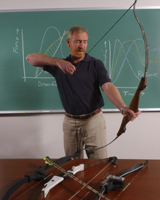| |
 |
Classic
Bow Redesigned to Shoot Farther, Easier
|
 |
| Dave
Jenkins, an avid archer, demonstrates a new bow he invented
that has a slight horizontal curl in its arms that makes
it easier to pull and causes the arrow to fly farther
without the complicated array of pulleys and cables on
a compound bow. |
downloadable
pdf
Inspired
by the workings of a tape measure, an engineer says he has
found a way to improve the bow used by hunters and warriors
since antiquity without radically changing its form.
Dave Jenkins, a mechanical and aerospace engineer at the University
of Florida with a longtime interest in archery, has redesigned
the classic bow so it is easier to pull and shoots farther.
Unlike the compound bow, a popular 30-year-old design that
relies on a complicated system of pulleys and cables for its
enhancements, Jenkins’ adaptation is not easy to distinguish
from the familiar model still used by traditionalist hunters
and indigenous people worldwide.
“My bow has many of the performance characteristics
of the compound bow but without all the cables and gizmos,”
said Jenkins. “It doesn’t weigh much, and it’s
simple and easy to carry. With these compound bows, you feel
like ‘Rambo the Commando’ or something.”
The bow, patented by UF last year, may be of interest to bow
hunters and target archers. Nationwide, there are roughly
3.5 million licensed bow hunters, said Mary Beth Vorwerk,
spokesperson for USA Archery, an industry trade group. The
total number of target and hunter archers nationwide is unknown,
but the National Sporting Goods Association estimates the
figure at 6 million.
Invented in 1969, the compound bow uses pulleys known as eccentric
cams to make the string easier to pull as an archer draws
the bow. This draw gets harder with traditional bows, which
is one of the reasons it was revised. Compound bows are also
easier to hold cocked at full draw, which improves shooters’
accuracy because it makes aiming more comfortable.
With a traditional bow the string travels at maximum acceleration
the moment it is released, tending to wobble the arrow as
it clears the bow. This has the effect of slowing and shortening
its travel distance, Jenkins said. With a compound bow, the
string hits peak acceleration near the end of its movement,
which sends arrows on a straighter and thus faster path.
Compound bows comprise the vast share of the archery market.
They are so popular, Jenkins said, because they allow hunters
and archers who might otherwise not have the necessary strength
to shoot arrows forcefully and accurately.
But Jenkins, an experienced hunter, said the bows leave much
to be desired aesthetically because they are so machine-like.
He was casting around for ways to improve traditional bows
when he was inspired by a tape measure on his desk.
Tape measures have a slight curl in their horizontal surface,
which gives them considerable strength when they are extended
in a straight line. As soon as gravity or some other force
straightens the curl, however, they bend easily, which is
how these seemingly straight objects retract into a circular
coil in the case.
Like a tape measure, Jenkins’ bow has a slight horizontal
curl everywhere but the handle. As the archer pulls the string,
the curl gradually straightens, making the bow progressively
easier to pull. When the archer releases the arrow the bow’s
curl returns, adding power to the arrow’s flight. As
with the compound bow, the moment of maximum power occurs
as the arrow clears the bow, when the bow reaches its full
curl, which also improves accuracy.
Jenkins said his bow isn’t as effective as a compound
bow, but it is superior to the traditional type. Although
he said he hasn’t done enough testing to peg the amount
of improvement with certainty, he estimates it makes arrows
fly about 10 percent faster than traditional bows.
As an engineering student at UF in the early 1960s, Jenkins,
then active in target archery, said he toyed with the idea
of improving the classic bow using the concepts he was learning
in his classes. But he never followed through, leaving the
compound bow to be invented by someone else, he said.
“I kept thinking, there has got to be a way to make
a better bow with pulleys and cables,” he said. “But
I never did it; I dropped it. This time I’m going to
finish it.”
Dave Jenkins, daj@mae.ufl.edu
by Aaron Hoover
|

